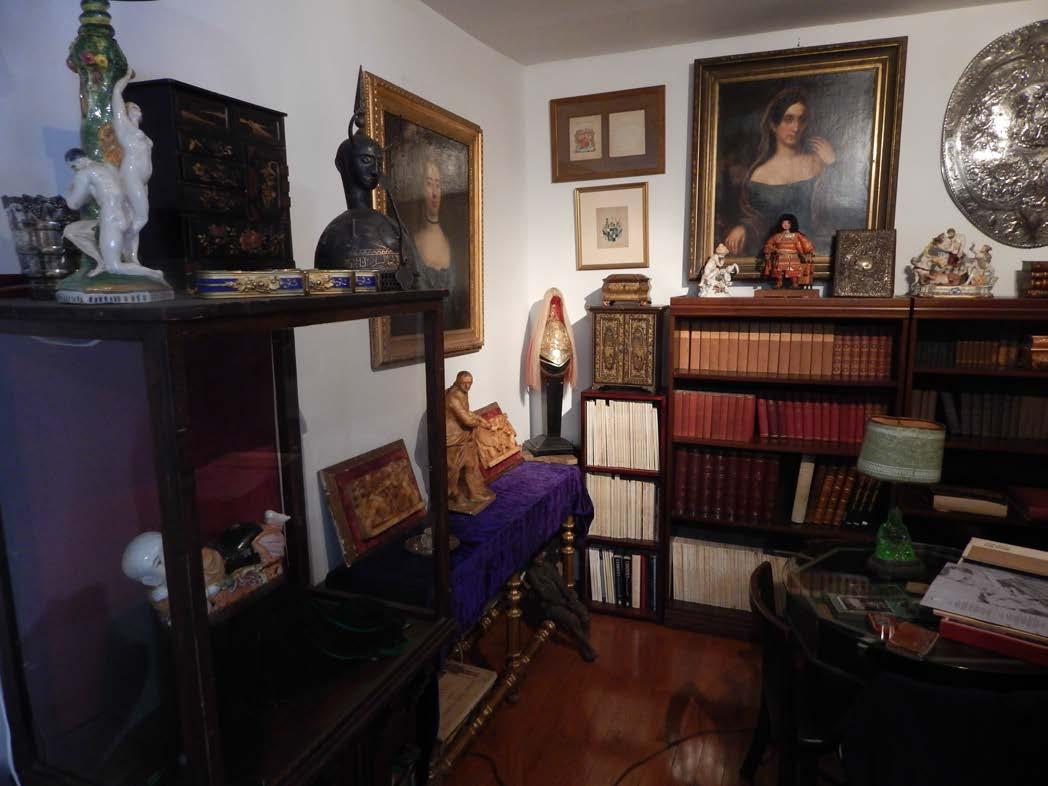
6 minute read
ROYAL DOCUMENT BEARING THE SEAL OF QUEEN ELIZABETH I
April 25th, 1599
Manuscript on Fine Vellum
Advertisement
Elizabeth I ( Queen of England and Ireland;1533-1603). Chancery grant to members of the Holland family, Humphrey Hills etc., relating to a messuage (dwelling house with outbuildings) at Darton alias Dartington, Ds. Jo Blandyle", Manuscript in Latin, in beautiful Chancery hand, on vellum, Privy Sea,l wax seal appended, seal intact with edges/impressions blunted, some surface wear slightly affecting text, folds, 500 x 720 mm. (App 19.6 x 28.25 in), 25th April 1599. This intriguing document is a relic of
Elizabethan England. As such it is contemporary with William Shakespeare, the Geneva Bible and the English Reformation. Notably, Oliver Cromwell was born on April 25, 1599!
Elizabeth I used this great seal during the second half of her reign - from 1586 to 1603. It is an impression from seal matrix made of bronze and was engraved by Nicholas Hilliard, who was famous for his small paintings or miniatures. His paintings are superbly executed and have a freshness and charm that has ensured his continuing reputation as "the central artistic figure of the Elizabethan age, the only English painter whose work reflects, in its delicate microcosm, the world of Shakespeare's earlier plays. "The matrix was used to create wax impressions that were used to 'seal' documents. This was a means of proving that the accompanying document had been written or approved by the owner of the seal. Seals were widely used by statesmen, nobles, judges, churchmen and even ordinary people. The great seal was the most important of all as the monarch used it to approve public acts and announcements. The inscription around the edge reads : 'Elizabetha dei gracia Anglie Francie et Hibernie Regina Fidei Defensor' (Elizabeth, by grace of God, Queen OF England, France AND Ireland, Defender OF the Faith ).
The beheading ax in the Tower of London with makers marks. It is very similar to the Yuko Foundation axe.
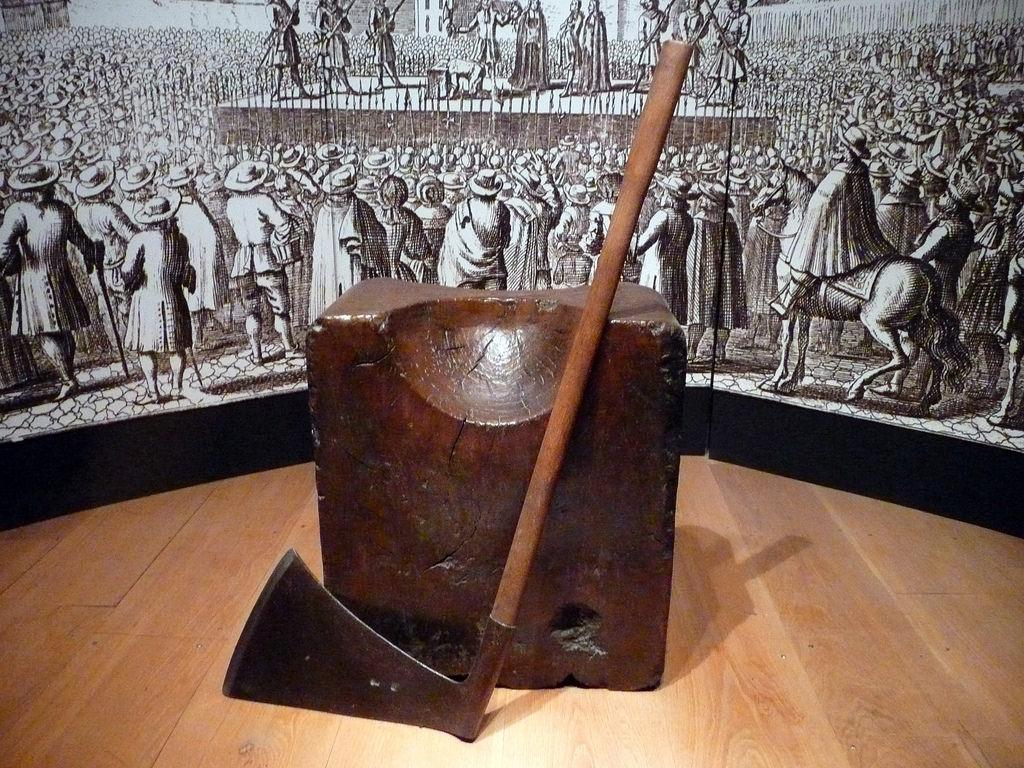
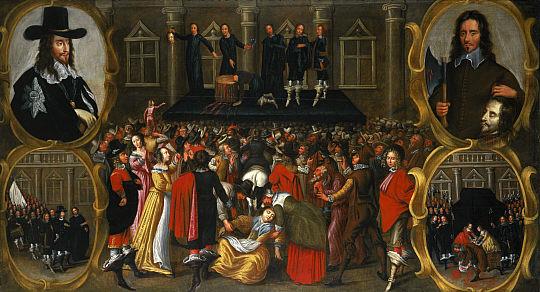


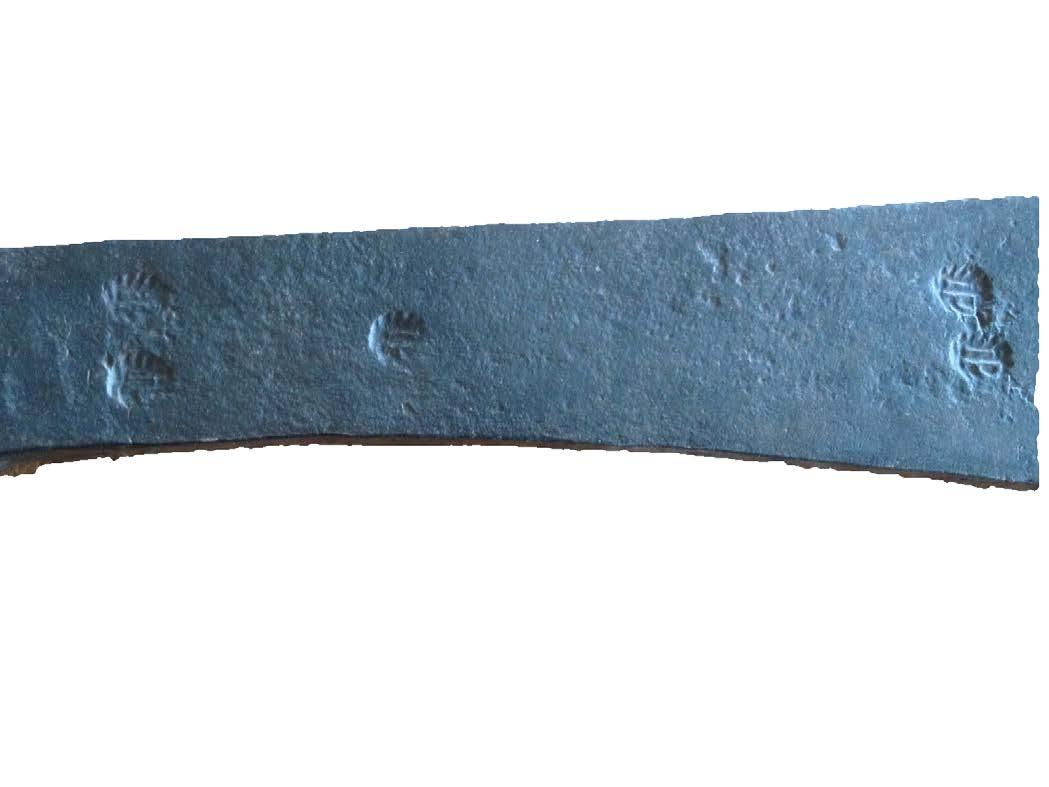
We solicited an opinion from the Royal Armouries about our axe. They were kind enough to reply as follows:
Dear Mr. Lindall,
Thank you for your email asking about a potential 17th C heading axe. Unfortunately the initials IP within a circular indent and on a striated background are not instantly identifiable – and in the current circumstances as I’m having to work away from the office I can’t access any of my references to check what if any 17 th C records there are of a similar mark. I will look them up when w e are permitted to return and let you know.

They are probably a maker’s mark, but sadly there is no guarantee that we can offer further identification. I’ve attached details of our so -called heading axe (XV.1), and should note that its maker’s marks remain anonymous.

The axe you’ve illustrated is a socket axe, and it has a relatively slim blade next to the socket compared to our example. I have yet to be convinced that a separate category of axes exist purely for beheading, and illustrations of executions (trustworthy contemporary ones are surprisingly few and far between) show a variety of heads and handle lengths being used. The execution of Charles I illustrated shows a very square bladed axe with short handle and Charles kneeling up to what appears to be a substantial trunk of tree. The executioner was disguised with fake beard and cap, and Charles questioned the small size of the block causing him to have to lay down on it – much as the Earl of Essex is recorded as doing in 1601. There were simply not enough beheadings to justify a specific type – however bloodthirsty we regard the past as. Beheading axes became so through use – and anything that lopped off a tree branch would do equal service in decapitation.
Bridget Clifford (Mrs)
Keeper of Tower Armouries
HM Tower of London
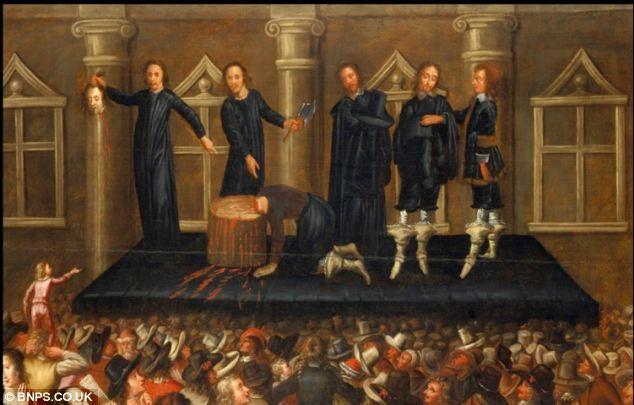


Defensio Regio & Defensio pro Populo Anglicano Bound Together Collection of the Yuko Nii Foundation


n 1649, in November, appeared the work for which many remember Salmasius best: his royalist tract Defensio regia pro Carolo I provoked by the execution of Charles I.

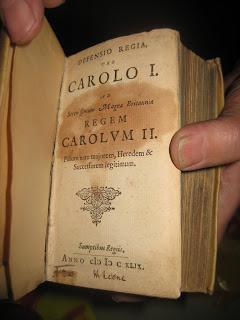
Defensio pro Populo Anglicano is a Latin polemic by John Milton, published in 1651. The full title in English is John Milton an Englishman His Defence of the People of England.[ The work includes invective against Salmasius and accusations of that scholar's inconsistency for taking contradictory positions. Milton also claims Salmasius wrote his work only due to being bribed with a "hundred Jacobuses" by the exiled son of Charles, who would later become King Charles II of England.[4] The level of ad hominem attack is high:
“...It were better for you to return to those illustrious titles of yours in France: first to that hunger starved Seigneurie of St. Loup, and next to that sacré Council of the Most Christian King; you are too far abroad from your own country for a counsellor. But I see full well that France desires not either you or your counsel, and did not, even when you were back a few years ago, and were beginning to smell out and hunt after a Cardinal's kitchen. She is right, by my troth, she is right, and can willingly allow you, you French capon, with your mankind wife and your desks chock-full of emptiness, to wander about, till somewhere in creation you light upon a dole bountiful enough for a grammarian-cavalier or illustrious hippo-critic, always supposing any king or state has a mind to bid highest for a vagabond pedant that is on sale....”
Authentic and scarce oblong folio document boldly signed "Charles R.," November 24, 1643, by the beleaguered English monarch.

The king entrusts Robert Ellys with our regiment of twelve hundred foot soldiers, "to furnish our armies with all things necessary for Our survival wheresoever you shall be able in Our kingdom of England...for the defence of Our Royal Person and posterity [and] the true reformed Protestant religion." Charles, a little over a year into the Civil War, has signed this order from his stronghold at Oxford. From this base, he hoped to cut off London, thus weakening the Parliamentary rebels.
The letter shows light discoloration around the edges and throughout the document, consistent with age (see photos). Light vertical and horizontal creases/fold marks are visible but do not detract from the viewing or value of the document. Some warping and fading.

EIKON BASILIKE.PORTRAITURE OF HIS SACRED MAJESTY.CHARLES 1,1648,ORIGINAL 269 PAGES
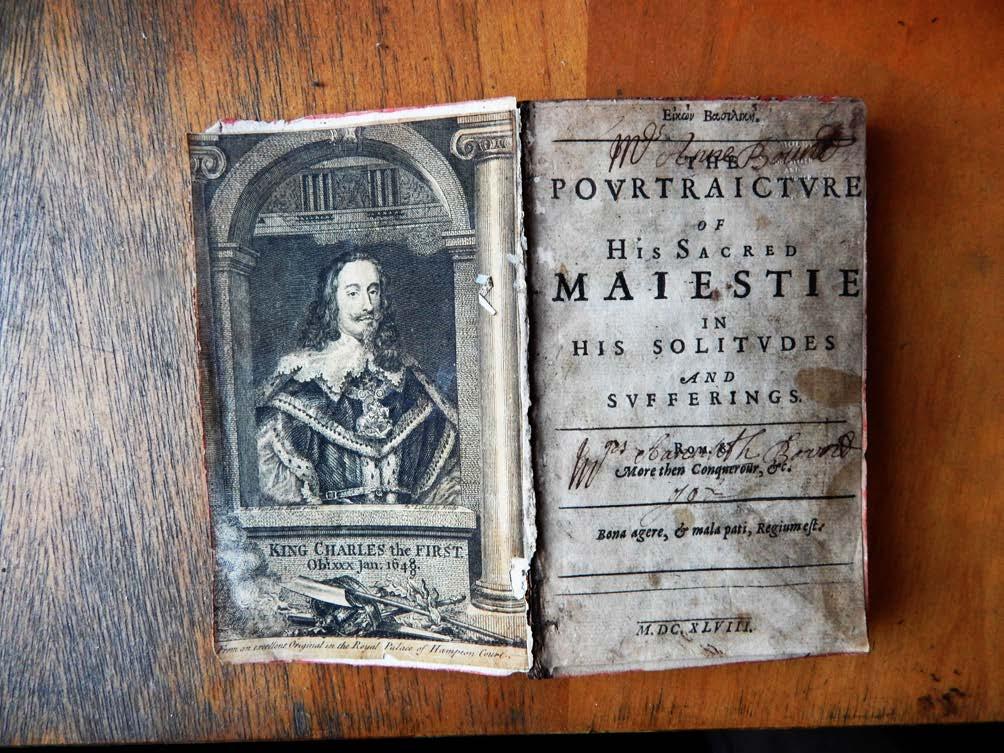
Sign ed on last page by Charles Shipley Collection Yuko Nii Foundation

On the next page is a MANUSCRIPT OF AN IMPORTANT SPEECH QUEEN ELIZABETH I GAVE BEFORE THE BRITISH PARLIAMENT ON MARCH 29, 1585 in the collection of the Yuko Nii Foundation.
Elizabeth I gives a trenchant warning to Parliament about religion, very likely on Catholicism: “One thing I may not overskip. Religion, the ground on which all other matters ought to take root, and, being corrupted, may mar all the tree. And that there be some fault -finders with the order of the clergy, which so may make a slander to myself, and to the church, whose over-ruler God hath made me, whose negligence cannot be excused, if any schisms or errors heretical were suffered. Thus much I must say, that some faults and negligences must grow and be, as in all other great charges it happeneth; and what vocation without? All which, if you, my lords of the clergy, do not amend, I mean to depose you. Look ye, therefore, well to your charges.”.
Elizabeth I Gives A Trenchant Warning
TO PARLIAMENT ABOUT RELIGION THE SAME YEAR AN ACT WAS PASSED THAT OUTLAWED ORDAINED CATHOLIC PRIESTS IN ENGLAND
Elizabeth I persecuted Catholics and approved measures that outlawed Catholicism during her long reign. The same year the present speech was given, “An act against Jesuits and seminary priests” was passed which made it treason for any Catholic priest ordained abroad after 1559 to come into or remain in England and a felony for anyone to shelter or assist such a priest, treason and felony were both punishable by death. This action consolidated English society and made it possible over the following centuries to create the greatest empire the world has ever seen.
The writing is in “secretarial hand,” most commonly used at court during the Elizabethan period. This writing style is the direct precursor to our modern handwriting.
Bellow is part of a man uscript document in the Folger Shakespeare Library with remarkably similar handwriting in “secretarial hand.”

“The documents were written between with a goose-quill pen and an iron gall or carbon-based ink. Iron gall ink was made up from galls (usually oak-galls).
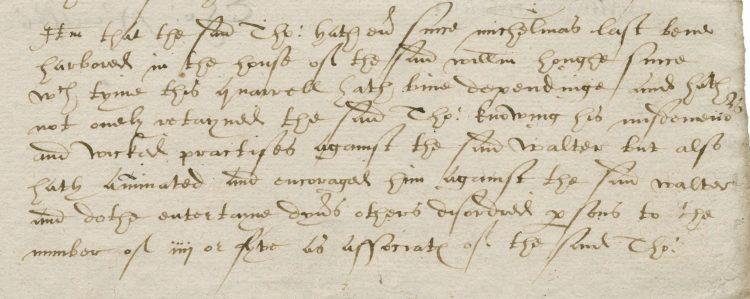
Above Testament of William Shakespeare in “secretarial hand.” , National Archives

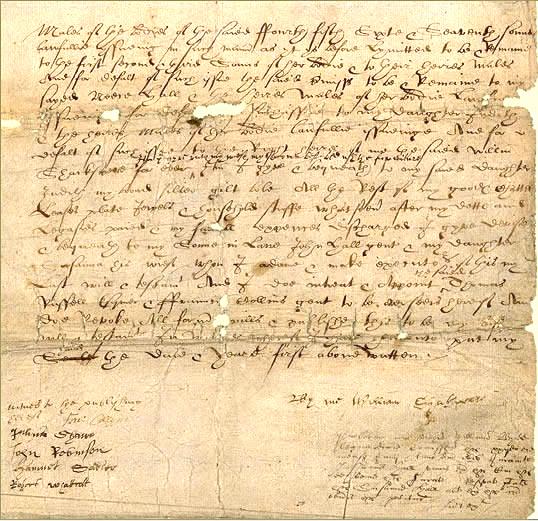
Below letter from Elizabeth to Robert Dudley in “secretarial hand.” , National Archives

Charles I's head had been off his shoulders for six weeks when John Milton accepted the office of Secretary for Foreign Tongues to the Commonwealth Council of State. He had announced his approval of th e execution in a pamphlet that came out within a few days of the event and throughout the struggle between Parliament and the King he had been a vigorous anti-Royalist polemicist.
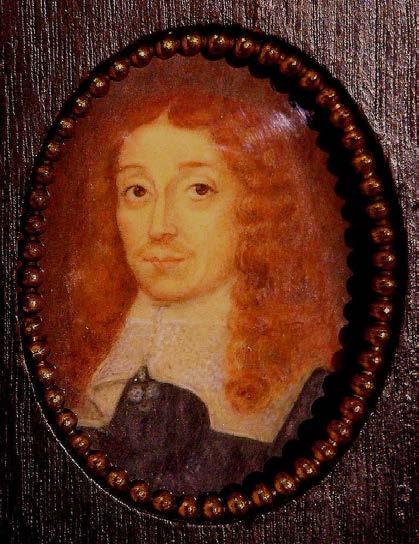
Under Cromwell, Milton became Foreign Sec retary. Latin was the language of international comm unication. Few foreign governments wished to have much to do with the regime in England, Milton could spend his time writing propaganda tracts for his employers. One of them was Eikonoklastes ('The Image -Breaker'), which came out in October, 1649. It was a counterblast to the Eikon Basilike ('The Royal Image'), believed to be an account of the last days of his life by the martyred Charles himself.
17 th C. Portrait Originally Thought to be of John Milton
Yuko Nii Foundation Collection
The coat of arms has yet to be identified
The Yuko Nii Foundation Library, where many of the historical objects are kept, houses a very fine small collection of art and manuscripts 15 th-20 th c. from around the world.
